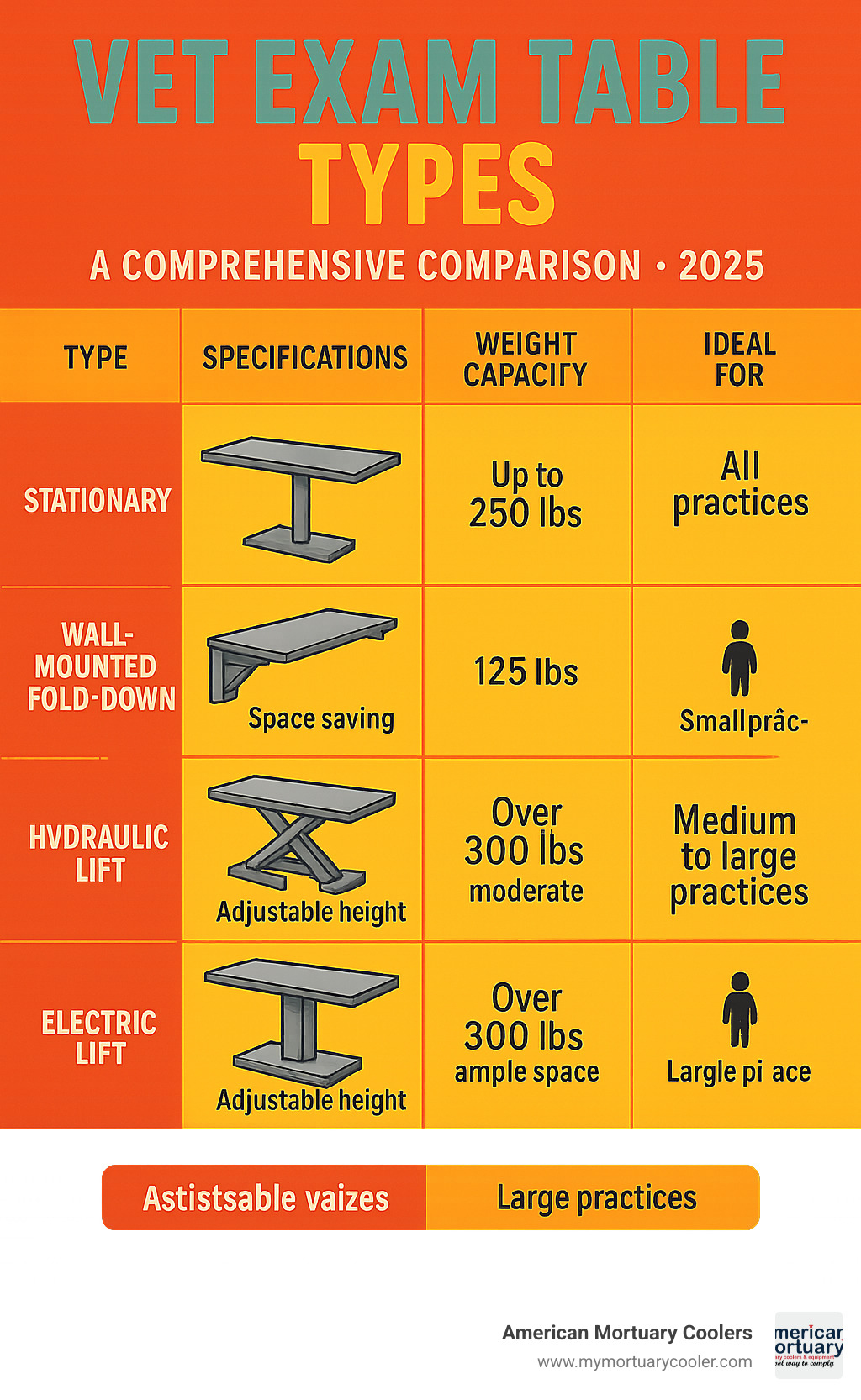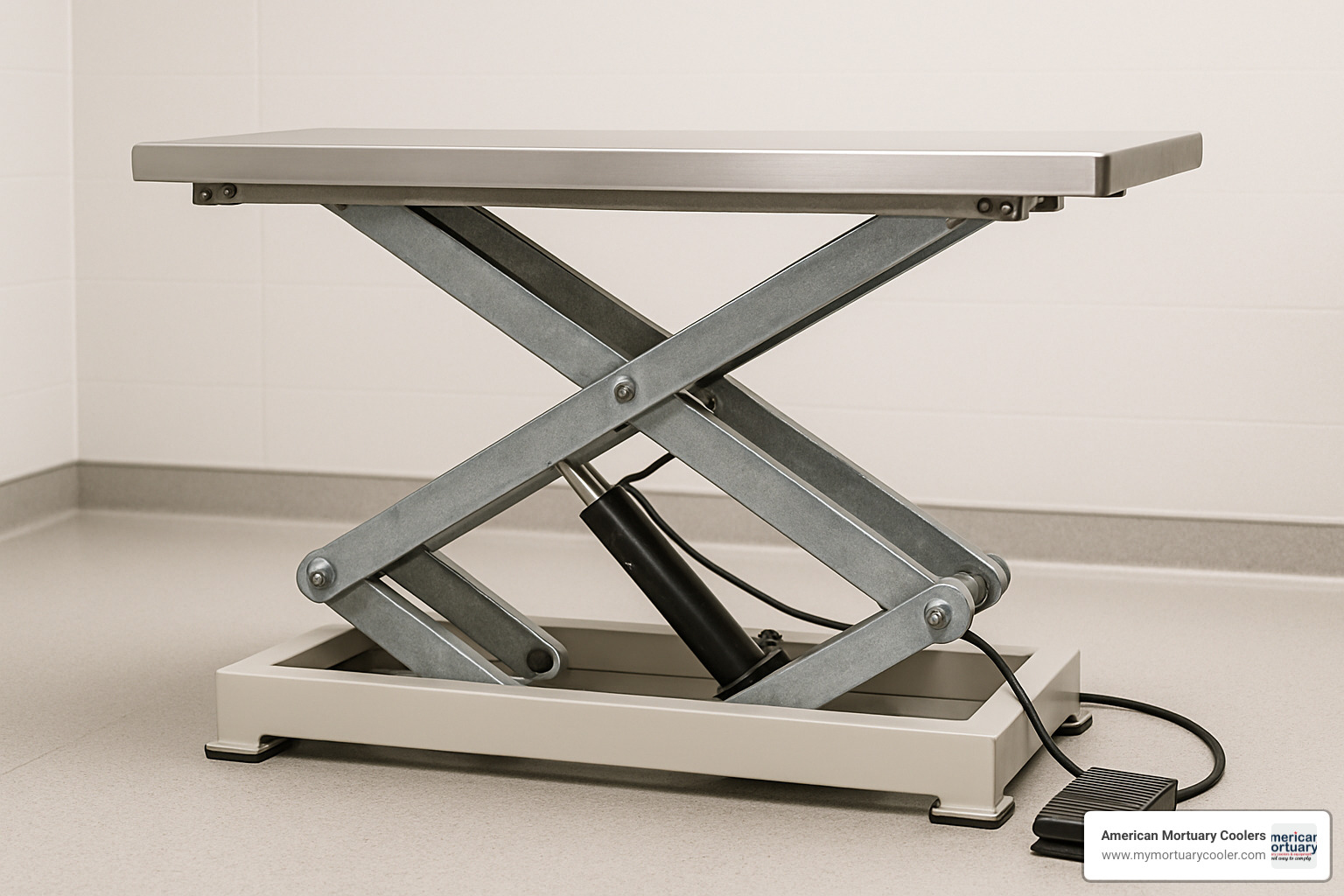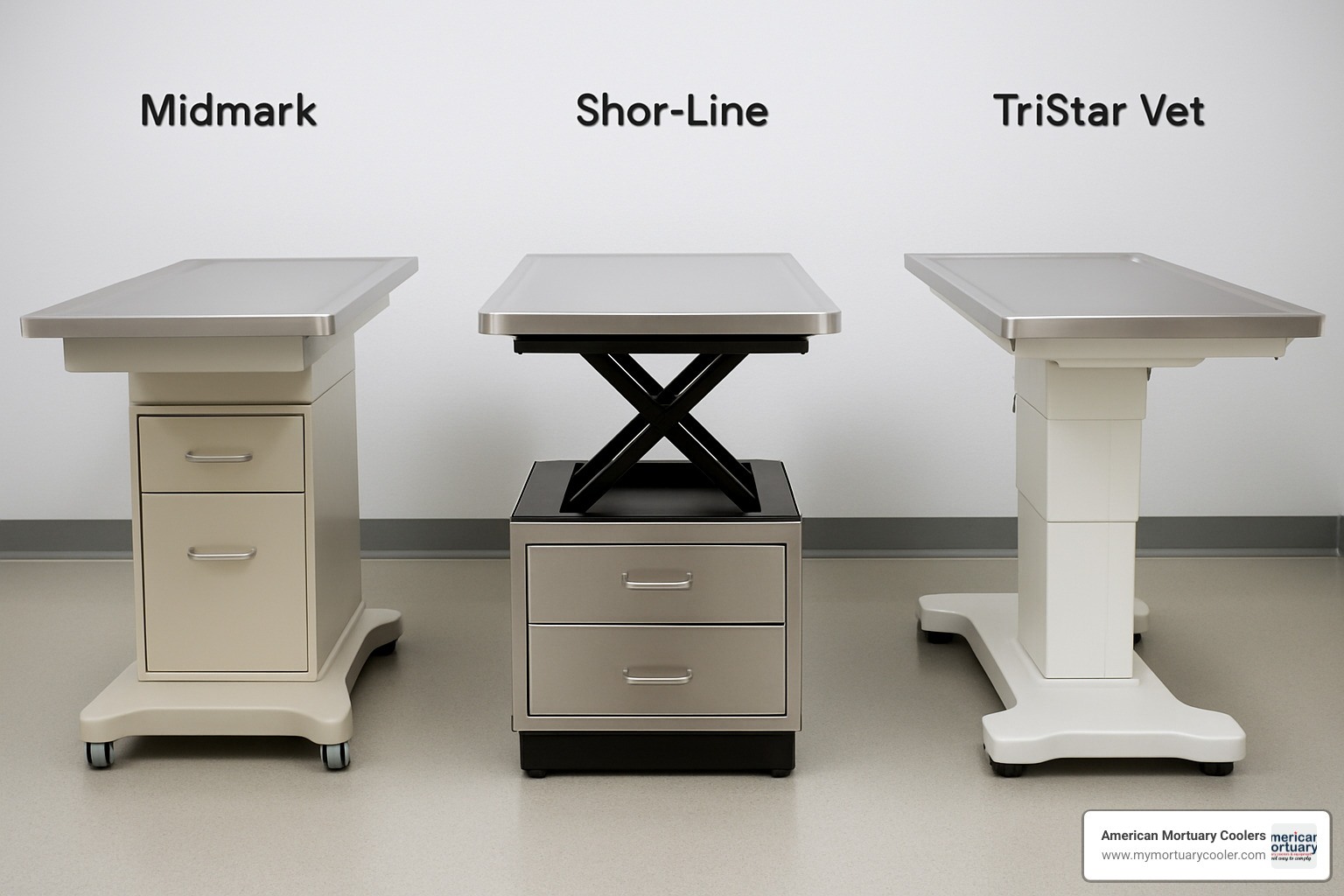Why the Right Vet-Exam-Table Makes All the Difference
A vet-exam-table is a specialized piece of veterinary equipment designed to provide a safe, hygienic, and ergonomic surface for examining animals. These tables come in various types including stationary, folding, wall-mounted, hydraulic, and electric models, each offering different benefits for space efficiency, staff ergonomics, and patient safety.
Key vet-exam-table types:
- Stationary tables - Fixed height, typically 32-36 inches
- Wall-mounted fold-down - Space-saving design, 125 lb capacity
- Hydraulic lift - Adjustable height, reduces staff strain
- Electric lift - Quiet operation, precise positioning
- Specialty tables - Dental tops, surgical configurations
The right exam table affects everything from patient safety to staff health. Research shows that fold-down exam tables can save significant floor space in veterinary clinics, while lift tables with gas-assist mechanisms reduce physical strain on veterinary staff.
Modern vet exam tables feature stainless steel construction for easy cleaning and infection control. Weight capacities range from 125 pounds for wall-mounted models to over 300 pounds for heavy-duty lift tables. The marine edge design prevents spills and supports proper hygiene protocols.
Space constraints, patient size, and workflow efficiency all play crucial roles in selecting the right table. A busy small-animal practice might prioritize wall-mounted fold-down models, while a large-animal clinic needs heavy-duty hydraulic lift tables.

Basic vet-exam-table vocab:
What Is a Veterinary Exam Table and Why It Matters
A vet-exam-table is a specialized table built specifically for examining and treating animals. These tables handle everything from a squirmy kitten's first checkup to restraining a nervous 80-pound dog during examination.
Restraint capabilities built into modern exam tables include attachment points for leashes, grooming arms, and positioning aids that keep pets secure without making them feel trapped. Examination quality improves dramatically when animals are positioned properly, allowing veterinarians to access all angles and perform procedures without awkward positioning.
Hygiene considerations drive design choices in veterinary exam tables. Stainless steel surfaces resist bacteria and handle repeated cleaning cycles. The smooth, non-porous materials prevent germs from hiding in cracks where they could spread between patients.
Stress reduction benefits everyone. Scientific research on handling stress shows that stable, secure surfaces help calm anxious animals. When pets feel safe, examinations go smoother and veterinarians can focus on providing care.
Staff health improvements come from ergonomic design. Adjustable height mechanisms prevent chronic back problems that plague veterinary professionals. Many vets develop serious musculoskeletal issues that could be prevented with better equipment.
Infection control protocols depend on table design and materials. Raised marine edges contain spills and prevent contaminated fluids from spreading. Easy-to-clean construction materials support thorough disinfection between patients.
The Role of the Vet-Exam-Table in Patient Safety
Patient safety starts with smart restraint methods that protect without causing distress. Modern tables integrate attachment points for various restraint devices, allowing veterinarians to secure animals appropriately based on size and temperament.
Non-slip surfaces prevent scary sliding incidents that can injure pets. Whether achieved through textured stainless steel or specialized grip coatings, these surfaces give animals confidence during examinations.
Weight capacity specifications are critical safety limits. Wall-mounted tables typically handle up to 125 pounds, while heavy-duty models support 300+ pounds. Exceeding these limits risks failures that could injure patients and staff.
Raised edges contain spills while preventing small animals from accidentally rolling off table surfaces. This feature has prevented countless accidents, especially with cats and small dogs.
Enhancing Clinic Workflow & Client Experience
Workflow efficiency improves when exam tables support smooth processes. Veterinarians can move around patients easily and maintain focus on medical care rather than fighting with inadequate surfaces.
Client perception often starts with examination room impressions. Professional-grade equipment signals competence and attention to detail. Pet owners notice when their animals are handled on quality surfaces with proper safety features.
Space layout optimization becomes crucial in busy practices. Wall-mounted fold-down tables free up floor space when not needed, allowing flexibility for larger patients or multiple-pet examinations.
Vet-Exam-Table Types, Designs, and Key Features
When shopping for a vet-exam-table, understanding construction materials makes all the difference. Stainless steel has become the gold standard - it's durable, resists corrosion, and cleans beautifully after messy examinations.
Most quality tables use 18-gauge stainless steel, which balances strength and affordability. Height adjustment mechanisms vary: manual gas-assist systems work without electricity, electric actuators provide precise positioning, while hydraulic systems deliver serious lifting power for heavy patients.
Noise levels during operation matter more than you might think. Modern electric lift systems run almost silently, keeping animals and owners calmer. Weight limits directly relate to construction - folding models typically max out around 220-275 pounds, while heavy-duty stationary tables accommodate much larger patients safely.
| Table Type | Weight Capacity | Height Range | Space Required | Best For |
|---|---|---|---|---|
| Stationary | 300+ lbs | Fixed 32-36" | Large footprint | High-volume clinics |
| Wall-mounted fold-down | 125 lbs | Fixed when deployed | Minimal when folded | Space-constrained rooms |
| Hydraulic lift | 250-400 lbs | 24-42" adjustable | Medium footprint | Mixed patient sizes |
| Electric lift | 200-350 lbs | 22-40" adjustable | Medium footprint | Ergonomic priority |
Stationary, Folding & Wall-Mount Vet-Exam-Table
Stationary wall-mount tables are veterinary workhorses. These fixed-height units provide rock-solid stability but limit you to one height. Fold-down designs have revolutionized how smaller clinics use space. The Eickemeyer® Fold Down Exam Table exemplifies smart engineering with gas strut operation for easy deployment.
Marine edges appear on most quality tables. These raised edges contain spills and keep examination tools from rolling onto floors - especially helpful with nervous animals. Gas-assist mechanisms have replaced manual folding systems because they're smoother to operate.
Space-saving benefits really add up in busy practices. When your vet-exam-table folds away, you free up floor space for equipment storage or emergency situations. More info about operating tables shows how efficient room design improves workflow.
Lift, Electric & Hydraulic Vet-Exam-Table

Hydraulic scissor lift systems are the heavy lifters, using hydraulic fluid pressure to smoothly raise and lower tables across impressive height ranges. Electric lift systems focus on quiet, precise operation - modern actuators run so quietly you'll barely notice them.
Ergonomic benefits drive many clinics to invest in lift tables. Adjustable height matching your natural working posture prevents back problems and improves examination quality. Large breed safety requires serious engineering with reinforced frames and powerful lifting systems.
Low-noise operation benefits everyone in the examination room. Quiet tables contribute to calmer environments, making communication easier and reducing stress responses in animals.
Specialty Tables: Dental, Surgical & Gurney Solutions
Dental-top configurations incorporate features for oral work including integrated lighting connections and angled surfaces. Surgery table adaptations include radiolucent tops for X-ray compatibility and accessory rails for equipment mounting.
MRI-conditional gurney solutions use non-ferromagnetic materials for safety in high-magnetic field environments. Scientific research on dental ergonomics emphasizes how proper positioning improves outcomes.
Mobility features extend utility beyond fixed rooms. Integration ports accommodate growing arrays of accessories including electrical outlets and mounting points for scales and monitors.
How to Choose the Right Vet-Exam-Table for Your Clinic
Choosing the perfect vet-exam-table becomes manageable by focusing on key factors. Start with your patient species and size range. A cats-only practice can use lightweight wall-mounted tables, but practices seeing Great Danes need 300+ pound capacity tables.
Clinic space often becomes the deciding factor. Measure everything twice - room dimensions, door widths, and ceiling height for lift tables. Budget considerations extend beyond initial price. Electric lift tables seem expensive but prevent costly worker's compensation claims from staff injuries.
Your intended use patterns matter significantly. Busy spay-neuter clinics need tables that clean quickly and withstand constant use. Don't overlook power availability - electric models need dedicated circuits while gas-assist systems work without electricity.
Warranty coverage and manufacturer support can make or break your experience. Look for comprehensive warranties and responsive technical support for when equipment breaks down.
Vet-Exam-Table Buyer's Checklist
Before choosing any table, measure your rooms carefully, including door clearances and ceiling-mounted equipment. Weight ratings should comfortably exceed your heaviest patients - build in safety margins.
Consider adjustability range based on staff heights and procedures performed. Look for accessory ports and mounting options that expand utility over time. Cleaning ease directly impacts daily workflow - smooth surfaces and chemical-resistant materials save time.
Calculate ROI including direct savings from reduced staff injuries and indirect benefits like improved client satisfaction and professional image.
Leading Brands & What Sets Them Apart

Midmark dominates with comprehensive product lines and excellent dealer support. Their folding exam tables feature smooth gas-assist mechanisms and standard dimensions with 125-pound capacity. They focus on ergonomic design and space-saving solutions.
Shor-Line built their reputation on durability and customization. Their stationary wall-mount tables include thoughtful touches like built-in instrument storage. For high-volume practices demanding robust performance, Shor-Line delivers.
TriStar Vet specializes in wall-mounted solutions using heavy-duty 18-gauge stainless steel. Their tables come in multiple configurations with tension-release trigger mechanisms for smooth operation.
Vet-Tables differentiates through virtually noise-free operation and precise height settings. Their product line spans basic scissor tables to sophisticated electric surgery tables and MRI-conditional gurneys.
Eickemeyer brings European engineering quality with premium stainless steel construction appealing to space-conscious practices seeking extra quality.
User reviews consistently praise durability, cleaning ease, and ergonomic benefits. Complaints usually center on installation complexity and maintenance requirements. More info about comparing stainless steel tables helps understand material quality differences affecting long-term satisfaction.
Maintenance, Ergonomics, and Future Trends
Taking care of your vet-exam-table requires consistency but doesn't have to be complicated. Daily cleaning should become second nature. Stainless steel surfaces handle most veterinary disinfectants beautifully, but harsh chemicals can damage seals and moving parts.
When choosing disinfectants, quaternary ammonium compounds work great for everyday cleaning, while stronger bleach solutions tackle serious contamination. Always check manufacturer recommendations - many warranty claims get denied for using wrong cleaners.
Stainless steel longevity depends on proper care from day one. High-quality stainless steel looks fantastic for decades with proper maintenance. Setting up preventive care schedules prevents equipment failures during busy days.
Ergonomic height settings vary significantly. Every staff member has their ideal working height, and different procedures call for different positions. Smart practices keep reference charts showing optimal heights for team members and common procedures.
The staff injury reduction benefits are real and measurable. Research consistently shows adjustable height tables significantly cut back strain and repetitive stress injuries. Many practices track injury rates before and after upgrading - results often justify investment within the first year.
Looking ahead, smart table integration is making waves. IoT connectivity lets you monitor usage, track maintenance needs, and analyze performance remotely. Built-in scales automatically record patient weights in electronic medical records, eliminating data entry errors.
Antimicrobial coatings take infection control beyond traditional stainless steel, actively fighting bacterial and viral growth. More info about working tables explores similar innovations changing medical equipment design.
Daily & Annual Maintenance Essentials for a Vet-Exam-Table
Daily wipe-down procedures should follow manufacturer guidelines for approved cleaning agents. Lint-free cloths work best for stainless steel surfaces. Hinge lubrication needs vary by table type - folding tables need regular attention at pivot points.
For hydraulic lift mechanisms, monthly fluid checks are essential. Watch for leakage signs around seals. Electrical safety inspections should happen annually, checking power cords, switches, and ground fault protection.
Innovations Shaping the Next Generation of Vet-Exam-Table

Touchless controls solve problems we didn't realize we had. Foot pedals, proximity sensors, and voice activation let you adjust height without touching anything - valuable during sterile procedures.
Bluetooth scale integration makes patient weights automatically flow into electronic medical records without manual entry. Quiet actuators keep getting better as electric lift technology advances, operating almost silently with precise positioning.
Sustainable materials address growing environmental awareness with recycled stainless steel, eco-friendly coatings, and energy-efficient systems. Some manufacturers offer take-back programs for end-of-life equipment recycling.
Frequently Asked Questions about Vet-Exam-Table Selection
When choosing a vet-exam-table for your practice, certain questions come up again and again. Let me address the most common concerns I hear from veterinary professionals who want to make the right choice for their clinic.
How much weight can a typical vet-exam-table support?
The weight capacity of your vet-exam-table depends entirely on its design and construction. This is one of those "it depends" answers that actually matters quite a bit for your daily operations.
Wall-mounted folding tables typically handle around 125 pounds (about 57 kg). That works perfectly for cats and small to medium dogs - basically your everyday small animal practice patients. These space-saving designs prioritize convenience over heavy-duty capacity.
Heavy-duty stationary tables are the workhorses that can support 300-400 pounds or more. These robust units handle large breed dogs, some exotic species, and even multiple small animals during group examinations. The trade-off is a larger footprint and higher cost.
Hydraulic and electric lift tables usually fall somewhere in between, typically supporting 250-350 pounds while offering the ergonomic benefits of height adjustment. The research shows that folding exam tables can support patient capacities ranging from 100 kg (220 lbs) for fold-down models.
Here's the key: always maintain a safety margin above your heaviest typical patients. If you regularly see 80-pound dogs, don't cut it close with a 100-pound capacity table. Your staff's confidence and your patient's safety depend on having adequate capacity reserves.
What materials are easiest to disinfect and maintain?
Stainless steel remains the gold standard for veterinary exam tables, and there's good reason why it dominates the market. This material offers the perfect combination of durability, hygiene, and practicality that busy veterinary practices need.
The research confirms that stainless steel is the most common material used in veterinary exam tables due to its durability, ease of cleaning, and ability to support proper hygiene practices. Its non-porous surface means bacteria and viruses can't hide in tiny cracks or absorb into the material.
18-gauge stainless steel construction provides the sweet spot between durability and cost-effectiveness. It's thick enough to resist dents and scratches from daily use, but not so heavy that it becomes impractical for folding or lift mechanisms.
Raised marine edges make cleaning even easier by containing spills and preventing fluids from running onto floors or equipment. You can disinfect thoroughly without worrying about contamination spreading beyond the table surface.
Avoid tables with excessive joints, seams, or textured surfaces that create hiding spots for bacteria. The smoother and simpler the surface, the easier your daily cleaning routine becomes. Your staff will thank you during those busy days when every minute counts.
Do lift tables really reduce staff injuries?
Absolutely - and the difference is more dramatic than many practice owners expect. Adjustable height tables significantly reduce musculoskeletal strain on veterinary staff, and the research backs this up completely.
The research indicates that veterinary exam tables with gas-assist or tension-release mechanisms allow for easy, ergonomic raising and lowering, reducing physical strain on veterinary staff. This isn't just about comfort - it's about preventing career-ending injuries.
Ergonomic benefits extend far beyond back strain reduction. When your team can adjust table height to match their optimal working posture, they experience less shoulder stress, reduced neck strain, and improved examination quality. Staff fatigue decreases noticeably during long workdays.
Many practices report measurable reductions in worker compensation claims after upgrading to adjustable height tables. The initial investment pays for itself through reduced injury costs, improved staff retention, and better overall morale.
Consider this: your veterinarians and technicians perform hundreds of examinations each month. Each time they bend awkwardly or strain to reach a patient, they're adding wear and tear to their bodies. Lift tables eliminate most of this repetitive stress, protecting your most valuable assets - your skilled staff members.
The quiet operation of modern electric lift systems adds another benefit by reducing stress for noise-sensitive animals, creating a calmer examination environment for everyone involved.
Conclusion
Choosing the perfect vet-exam-table means investing in your patients' comfort, staff wellbeing, and clinic efficiency. Whether you need a compact wall-mounted fold-down model or a robust hydraulic lift system, each option serves a specific purpose.
Modern exam tables do far more than hold animals during checkups. Stainless steel construction fights infection daily. Raised marine edges save floors from spills. Adjustable height mechanisms prevent back pain after examining multiple patients.
Smart shopping means matching your table to your reality. A busy cat clinic has different needs than a practice seeing large dogs. Consider your space, measure carefully, and think about daily workflow. The right table makes everyone's job easier.
Here at American Mortuary Coolers, we've perfected stainless steel craftsmanship for healthcare environments. While we specialize in mortuary and funeral industry equipment, our understanding of durable, hygienic construction spans medical applications. We create custom stainless steel solutions serving clients from Tennessee to California, New York to Texas.
The future looks bright for veterinary equipment. Smart tables with built-in scales, touchless controls, and antimicrobial coatings are changing how veterinarians work, building on today's proven designs to make everything smoother and safer.
Ready to upgrade your examination setup? Involve your whole team in the decision - they'll use this equipment daily. Consider current pain points, dream about ideal workflow, and remember that quality equipment pays for itself through improved efficiency and fewer workplace injuries.
Your patients deserve the best care possible, starting with the right tools. A well-chosen vet-exam-table supports every aspect of quality veterinary medicine - from routine wellness checks to complex procedures. It's an investment in your practice's success and professional satisfaction.
More info about embalming table options showcases our dedication to superior stainless steel construction across healthcare settings. Whether selecting veterinary exam tables or exploring other medical equipment needs, the fundamentals remain: durability, cleanliness, and thoughtful design make all the difference.


















